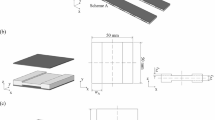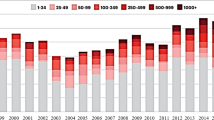Abstract
The reduction of vibration by acoustic black holes (ABHs) with damping treatments can be achieved in two stages: energy focalization and energy dissipation. The energy focalization is mainly due to changes of the local thickness by slowing down the flexural wave speed and energy dissipation can be achieved by using viscoelastic damping materials. In structures with embedded ABHs, the damping effectiveness can depend significantly on the types of damping treatments. In this paper, 4 different damping treatments according to the types of attached region are considered in order to estimate the effectiveness of damping treatments as 1) a fully-covered unconstrained damping treatment, 2) a fully-covered constrained damping treatment, 3) a partially-covered unconstrained damping treatment and 4) a partially- covered constrained damping treatment as well as no damping treatment as reference data. In this study, the performance of damping treatments is explored using numerical simulations of three-dimensional thin plate embedded truncated ABH(s). The wave energy in the ABH, the normalized total energy and the focalization ratio are introduced to compare the effectiveness of the damping treatments. The numerical results show that the fully-covered constrained damping treatment provides the most effective configuration in terms of the wave energy in ABH and the normalized total energy.
Similar content being viewed by others
References
S. Y. Kim and D. H. Lee, Identification of fractionalderivative-model parameters of viscoelastic materials from measured FRFs, Journal of Sound and Vibration, 324 (2009) 570–586.
S. Y. Kim, C. K. Mechefske and I. Y. Kim, Optimal damping layout in a shell structure using topology optimization, Journal of Sound and Vibration, 332 (2013) 2873–2883.
D. I. G. Jones, Handbook of viscoelastic vibration damping, John Wiley & Sons, New York (2001).
C. T. Sun and T. P. Lu, Vibration damping of structural elements, Prentice-Hall, Inc., London (1995).
T. Yamamoto, T. Yamada, K. Izui and S. Nishiwaki, Topology optimization of free-layer damping material on a thin panel for maximizing modal loss factors expressed by only real eigenvalues, Journal of Sound and Vibration, 358 (2015) 84–96.
L. Zhao, Passive vibration control based on embedded acoustic black holes, Journal of Vibration and Acoustics, 138 (4) (2016) 041003–9.
V. V. Krylov, Acoustic black hole: Recent developments in the theory and applications, IEEE Transactions on Ultrasonics, Ferroelectrics and Frequency Control, 61 (8) (2016) 1296–1306.
W. Huang, H. Ji, J. Qiu and L. Cheng, Wave energy focalization in a plate with imperfect two-dimensional acoustic black hole indentation, Journal of Vibration and Acoustics, 138 (6) (2016) 061004–12.
L. Zhao and F. Semperlotti, Embedded acoustic black holes for semi-passive broadband vibration attenuation in thin-walled structures, Journal of Sound and Vibration, 388 (2017) 42–52.
E. P. Bowyer, D. J. O’Boy, V. V. Krylov and F. Gautier, Experimental investigation of damping flexural vibrations in plates containing tapered indentations of power-law profile, Applied Acoustics, 71 (2013) 553–560.
V. B. Gergiev, J. Cuenca, F. S. Gautier and V. V. Krylov, Damping of structural vibrations in beams and elliptical plates using the acoustic black hole effect, Journal of Sound and Vibration, 333 (2011) 2497–2508.
S. C. Conlon, J. B. Fahnline and F. Semperlotti, Numerical analysis of the vibroacoustic properties of plates with embedded grids of acoustic black holes, The Journal of the Acoustical Society of America, 137 (2015) 447–457.
E. P. Bowyer and V. V. Krylov, Experimental study of sound radiation by plates containing circular indentations of power-law profile, Applied Acoustics, 88 (2015) 30–37.
L. Zhon, S. C. Conlon and F. Semperlotti, An experimental study of vibration based energy harvesting in dynamically tailored structures with embedded acoustic black holes, Smart Materials and Structures, 24 (2015) 065039.
S. C. Conlon and J. B. Fahnline, Numerical analysis of the vibroacoustic properties of plates with embedded grids of acoustic black hole, Journal of Acoustical Society of America, 137 (2015) 447–457.
V. Denis, A. Pelat, C. Touze and F. Gautier, Improvement of the acoustic black hole effect by using energy transfer due to geometric nonlinearity, International Journal Non-Linear Mechanics, 94 (2017) 134–145.
D. H. Lee, S. J. Kang and S. Y. Kim, Vibration characteristics of circular acoustic black hole plate with constrained damping layer, Proceedings of the 5th Japan-Korea Joint Symposium on Dynamics & Control, Aug. 29–30 (2017).
D. H. Lee, S. J. Kang and Y. W. Won, Vibrational characteristics of an acoustic black hole plate with constrained layer damping, 2017 Joint Conference by KSNVE, ASK and KSME(DC), Apr. 26–18 (2017).
E. P. Bowyer and V. V. Krylov, A review of experimental investigations into the acoustic black hole effect and its applications for reduction of flexural vibrations and structure-borne sound, Inter-Noise 2015, San Francisco California, August (2015).
J. S. Bendat and A. G. Piersol, Random data: Analysis and measurement procedures, 3rd Edition, John Wiley & Sons Inc. (2000).
Author information
Authors and Affiliations
Corresponding author
Additional information
Recommended by Associate Editor Junhong Park
Sun-Yong Kim received his Ph.D. degree from Mechanical and Materials Engineering at Queen’s University at Kingston in 2011. He worked as a Senior Research Engineer at Samsung Electronics and Hanwha Corporation from 2011 to 2016. He is currently working at Ulsan College as an Assistant Professor since March 2016. His research interests include design optimization, finite element analysis, vibration control and so on.
Dooho Lee received his B.S. degree from Seoul National University (Korea) in 1988, his M.S. from KAIST (Korea) in 1990, and his Ph.D. from KAIST (Korea) in 1994. He worked for Samsung Motors, Inc. (1995-1999), and is currently a Professor in Dongeui University. His research focuses on the design optimization of structural-acoustic systems, uncertainty propagation in dynamic problems, and sound transfer characteristics in human hearing systems.
Rights and permissions
About this article
Cite this article
Kim, SY., Lee, D. Numerical analysis of wave energy dissipation by damping treatments in a plate with acoustic black holes. J Mech Sci Technol 32, 3547–3555 (2018). https://doi.org/10.1007/s12206-018-0705-8
Received:
Revised:
Accepted:
Published:
Issue Date:
DOI: https://doi.org/10.1007/s12206-018-0705-8




